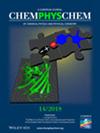Saikat Hazra, Subhali Basu, Soumya Mukherjee, Satyam Ravi, Subhankar Sardar, Satrajit Adhikari
求助PDF
{"title":"o- c6 $_{6}$ h4 $_{4}$ f2 + $_{2}^{+}$自由基阳离子非绝热表面的构造:光电子和质量分析阈值电离谱的计算。","authors":"Saikat Hazra, Subhali Basu, Soumya Mukherjee, Satyam Ravi, Subhankar Sardar, Satrajit Adhikari","doi":"10.1002/cphc.202500461","DOIUrl":null,"url":null,"abstract":"<p><p>Theoretically \"exact\" and numerically \"accurate\" Beyond Born-Oppenheimer (BBO)-based diabatic Hamiltonian for an aromatic radical cation, namely, o- <math> <semantics> <mrow><msub><mi>C</mi> <mn>6</mn></msub> </mrow> <annotation>$_{6}$</annotation></semantics> </math> H <math> <semantics> <mrow><msub><mrow></mrow> <mn>4</mn></msub> </mrow> <annotation>$_{4}$</annotation></semantics> </math> F <math> <semantics> <mrow><msubsup><mrow></mrow> <mn>2</mn> <mo>+</mo></msubsup> </mrow> <annotation>$_{2}^{+}$</annotation></semantics> </math> , is constructed theoretically for the first time, where the low-lying five electronic states ( <math> <semantics> <mrow> <msup><mover><mi>X</mi> <mo>˜</mo></mover> <mn>2</mn></msup> <msub><mi>B</mi> <mn>1</mn></msub> </mrow> <annotation>$\\left(\\overset{sim}{X}\\right)^{2} B_{1}$</annotation></semantics> </math> , <math> <semantics> <mrow> <msup><mover><mi>A</mi> <mo>˜</mo></mover> <mn>2</mn></msup> <msub><mi>A</mi> <mn>2</mn></msub> </mrow> <annotation>$\\left(\\overset{sim}{A}\\right)^{2} A_{2}$</annotation></semantics> </math> , <math> <semantics> <mrow> <msup><mover><mi>B</mi> <mo>˜</mo></mover> <mn>2</mn></msup> <msub><mi>B</mi> <mn>1</mn></msub> </mrow> <annotation>$\\left(\\overset{sim}{B}\\right)^{2} B_{1}$</annotation></semantics> </math> , <math> <semantics> <mrow> <msup><mover><mi>C</mi> <mo>˜</mo></mover> <mn>2</mn></msup> <msub><mi>A</mi> <mn>1</mn></msub> </mrow> <annotation>$\\left(\\overset{sim}{C}\\right)^{2} A_{1}$</annotation></semantics> </math> , and <math> <semantics> <mrow> <msup><mover><mi>D</mi> <mo>˜</mo></mover> <mn>2</mn></msup> <msub><mi>B</mi> <mn>2</mn></msub> </mrow> <annotation>$\\left(\\overset{sim}{D}\\right)^{2} B_{2}$</annotation></semantics> </math> ) are nonadiabatically coupled with each other, exhibiting conical intersections (CIs)/seams due to accidental Jahn-Teller (JT) couplings as well as depicting pseudo-Jahn-Teller interactions. Once the diabatic PESs and couplings are constructed, those are used to execute multistate multimode nuclear dynamics for generating photoelectron (PE) and mass-analyzed threshold ionization spectra of the neutral analog. The calculated PE spectra for <math> <semantics> <mrow> <msup><mover><mi>X</mi> <mo>˜</mo></mover> <mn>2</mn></msup> <msub><mi>B</mi> <mn>1</mn></msub> </mrow> <annotation>$\\left(\\overset{sim}{X}\\right)^{2} B_{1}$</annotation></semantics> </math> , <math> <semantics> <mrow> <msup><mover><mi>A</mi> <mo>˜</mo></mover> <mn>2</mn></msup> <msub><mi>A</mi> <mn>2</mn></msub> </mrow> <annotation>$\\left(\\overset{sim}{A}\\right)^{2} A_{2}$</annotation></semantics> </math> , <math> <semantics> <mrow> <msup><mover><mi>B</mi> <mo>˜</mo></mover> <mn>2</mn></msup> <msub><mi>B</mi> <mn>1</mn></msub> </mrow> <annotation>$\\left(\\overset{sim}{B}\\right)^{2} B_{1}$</annotation></semantics> </math> , <math> <semantics> <mrow> <msup><mover><mi>C</mi> <mo>˜</mo></mover> <mn>2</mn></msup> <msub><mi>A</mi> <mn>1</mn></msub> </mrow> <annotation>$\\left(\\overset{sim}{C}\\right)^{2} A_{1}$</annotation></semantics> </math> and <math> <semantics> <mrow> <msup><mover><mi>D</mi> <mo>˜</mo></mover> <mn>2</mn></msup> <msub><mi>B</mi> <mn>2</mn></msub> </mrow> <annotation>$\\left(\\overset{sim}{D}\\right)^{2} B_{2}$</annotation></semantics> </math> states originated from the BBO-based diabatic Hamiltonian in conjunction with time-dependent discrete variable representation (TDDVR) dynamics show peak-by-peak correspondence with the experimental spectral bands as well as with other theoretical findings.</p>","PeriodicalId":9819,"journal":{"name":"Chemphyschem","volume":" ","pages":"e202500461"},"PeriodicalIF":2.2000,"publicationDate":"2025-10-01","publicationTypes":"Journal Article","fieldsOfStudy":null,"isOpenAccess":false,"openAccessPdf":"","citationCount":"0","resultStr":"{\"title\":\"<ArticleTitle xmlns:ns0=\\\"http://www.w3.org/1998/Math/MathML\\\">Construction of Beyond Born-Oppenheimer-Based Diabatic Surfaces of o- <ns0:math> <ns0:semantics> <ns0:mrow><ns0:msub><ns0:mi>C</ns0:mi> <ns0:mn>6</ns0:mn></ns0:msub> </ns0:mrow> <ns0:annotation>$_{6}$</ns0:annotation></ns0:semantics> </ns0:math> <ns0:math> <ns0:semantics> <ns0:mrow><ns0:msub><ns0:mi>H</ns0:mi> <ns0:mn>4</ns0:mn></ns0:msub> </ns0:mrow> <ns0:annotation>$_{4}$</ns0:annotation></ns0:semantics> </ns0:math> <ns0:math> <ns0:semantics> <ns0:mrow><ns0:msubsup><ns0:mi>F</ns0:mi> <ns0:mn>2</ns0:mn> <ns0:mo>+</ns0:mo></ns0:msubsup> </ns0:mrow> <ns0:annotation>$_{2}^{+}$</ns0:annotation></ns0:semantics> </ns0:math> Radical Cation: Calculation of Photoelectron and Mass-Analyzed Threshold Ionization Spectra.\",\"authors\":\"Saikat Hazra, Subhali Basu, Soumya Mukherjee, Satyam Ravi, Subhankar Sardar, Satrajit Adhikari\",\"doi\":\"10.1002/cphc.202500461\",\"DOIUrl\":null,\"url\":null,\"abstract\":\"<p><p>Theoretically \\\"exact\\\" and numerically \\\"accurate\\\" Beyond Born-Oppenheimer (BBO)-based diabatic Hamiltonian for an aromatic radical cation, namely, o- <math> <semantics> <mrow><msub><mi>C</mi> <mn>6</mn></msub> </mrow> <annotation>$_{6}$</annotation></semantics> </math> H <math> <semantics> <mrow><msub><mrow></mrow> <mn>4</mn></msub> </mrow> <annotation>$_{4}$</annotation></semantics> </math> F <math> <semantics> <mrow><msubsup><mrow></mrow> <mn>2</mn> <mo>+</mo></msubsup> </mrow> <annotation>$_{2}^{+}$</annotation></semantics> </math> , is constructed theoretically for the first time, where the low-lying five electronic states ( <math> <semantics> <mrow> <msup><mover><mi>X</mi> <mo>˜</mo></mover> <mn>2</mn></msup> <msub><mi>B</mi> <mn>1</mn></msub> </mrow> <annotation>$\\\\left(\\\\overset{sim}{X}\\\\right)^{2} B_{1}$</annotation></semantics> </math> , <math> <semantics> <mrow> <msup><mover><mi>A</mi> <mo>˜</mo></mover> <mn>2</mn></msup> <msub><mi>A</mi> <mn>2</mn></msub> </mrow> <annotation>$\\\\left(\\\\overset{sim}{A}\\\\right)^{2} A_{2}$</annotation></semantics> </math> , <math> <semantics> <mrow> <msup><mover><mi>B</mi> <mo>˜</mo></mover> <mn>2</mn></msup> <msub><mi>B</mi> <mn>1</mn></msub> </mrow> <annotation>$\\\\left(\\\\overset{sim}{B}\\\\right)^{2} B_{1}$</annotation></semantics> </math> , <math> <semantics> <mrow> <msup><mover><mi>C</mi> <mo>˜</mo></mover> <mn>2</mn></msup> <msub><mi>A</mi> <mn>1</mn></msub> </mrow> <annotation>$\\\\left(\\\\overset{sim}{C}\\\\right)^{2} A_{1}$</annotation></semantics> </math> , and <math> <semantics> <mrow> <msup><mover><mi>D</mi> <mo>˜</mo></mover> <mn>2</mn></msup> <msub><mi>B</mi> <mn>2</mn></msub> </mrow> <annotation>$\\\\left(\\\\overset{sim}{D}\\\\right)^{2} B_{2}$</annotation></semantics> </math> ) are nonadiabatically coupled with each other, exhibiting conical intersections (CIs)/seams due to accidental Jahn-Teller (JT) couplings as well as depicting pseudo-Jahn-Teller interactions. Once the diabatic PESs and couplings are constructed, those are used to execute multistate multimode nuclear dynamics for generating photoelectron (PE) and mass-analyzed threshold ionization spectra of the neutral analog. The calculated PE spectra for <math> <semantics> <mrow> <msup><mover><mi>X</mi> <mo>˜</mo></mover> <mn>2</mn></msup> <msub><mi>B</mi> <mn>1</mn></msub> </mrow> <annotation>$\\\\left(\\\\overset{sim}{X}\\\\right)^{2} B_{1}$</annotation></semantics> </math> , <math> <semantics> <mrow> <msup><mover><mi>A</mi> <mo>˜</mo></mover> <mn>2</mn></msup> <msub><mi>A</mi> <mn>2</mn></msub> </mrow> <annotation>$\\\\left(\\\\overset{sim}{A}\\\\right)^{2} A_{2}$</annotation></semantics> </math> , <math> <semantics> <mrow> <msup><mover><mi>B</mi> <mo>˜</mo></mover> <mn>2</mn></msup> <msub><mi>B</mi> <mn>1</mn></msub> </mrow> <annotation>$\\\\left(\\\\overset{sim}{B}\\\\right)^{2} B_{1}$</annotation></semantics> </math> , <math> <semantics> <mrow> <msup><mover><mi>C</mi> <mo>˜</mo></mover> <mn>2</mn></msup> <msub><mi>A</mi> <mn>1</mn></msub> </mrow> <annotation>$\\\\left(\\\\overset{sim}{C}\\\\right)^{2} A_{1}$</annotation></semantics> </math> and <math> <semantics> <mrow> <msup><mover><mi>D</mi> <mo>˜</mo></mover> <mn>2</mn></msup> <msub><mi>B</mi> <mn>2</mn></msub> </mrow> <annotation>$\\\\left(\\\\overset{sim}{D}\\\\right)^{2} B_{2}$</annotation></semantics> </math> states originated from the BBO-based diabatic Hamiltonian in conjunction with time-dependent discrete variable representation (TDDVR) dynamics show peak-by-peak correspondence with the experimental spectral bands as well as with other theoretical findings.</p>\",\"PeriodicalId\":9819,\"journal\":{\"name\":\"Chemphyschem\",\"volume\":\" \",\"pages\":\"e202500461\"},\"PeriodicalIF\":2.2000,\"publicationDate\":\"2025-10-01\",\"publicationTypes\":\"Journal Article\",\"fieldsOfStudy\":null,\"isOpenAccess\":false,\"openAccessPdf\":\"\",\"citationCount\":\"0\",\"resultStr\":null,\"platform\":\"Semanticscholar\",\"paperid\":null,\"PeriodicalName\":\"Chemphyschem\",\"FirstCategoryId\":\"92\",\"ListUrlMain\":\"https://doi.org/10.1002/cphc.202500461\",\"RegionNum\":3,\"RegionCategory\":\"化学\",\"ArticlePicture\":[],\"TitleCN\":null,\"AbstractTextCN\":null,\"PMCID\":null,\"EPubDate\":\"\",\"PubModel\":\"\",\"JCR\":\"Q3\",\"JCRName\":\"CHEMISTRY, PHYSICAL\",\"Score\":null,\"Total\":0}","platform":"Semanticscholar","paperid":null,"PeriodicalName":"Chemphyschem","FirstCategoryId":"92","ListUrlMain":"https://doi.org/10.1002/cphc.202500461","RegionNum":3,"RegionCategory":"化学","ArticlePicture":[],"TitleCN":null,"AbstractTextCN":null,"PMCID":null,"EPubDate":"","PubModel":"","JCR":"Q3","JCRName":"CHEMISTRY, PHYSICAL","Score":null,"Total":0}
引用次数: 0
引用
批量引用

 求助内容:
求助内容: 应助结果提醒方式:
应助结果提醒方式:


